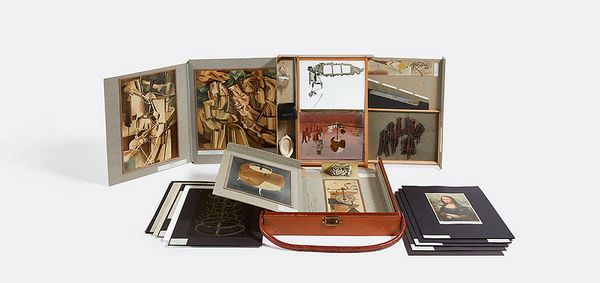Marcel Duchamp, De ou par Marcel Duchamp ou Rrose Sélavy (La Boîte-en-valise), series B, 1952. 20th Century & Contemporary Art, New York.
It is perhaps a synchronicity of history that Marcel Duchamp conceived of what would become La Bôite-en-valise in 1935, the same year Walter Benjamin's “The Work of Art in the Age of Mechanical Reproduction” was first published. The artist and the philosopher met on at least one occasion in 1937, when Duchamp showed Benjamin a pochoir-colored reproduction of Nude Descending a Staircase, which the latter noted as “breathtakingly beautiful” in a diary entry. Benjamin’s notion of the “aura” of the original work waning with each reproduction reaches a collision point with the valise: in seeking to destroy the inherent presence of the original, Duchamp uncovered a wider question of the place of art in an ever-increasingly shrinking, mechanized — and now fully digital — world. Let us then open the box and see what we find.
Object 1: Bottle Rack
Purchased in 1914 at a Parisian department store, Duchamp’s first readymade piece was an ordinary bottle drying rack deliberately unaltered and repositioned into a venerable art object. The original rack was, in fateful readymade fashion, discarded after being mistaken for garbage by Duchamp’s sister, leading him to purchase replicas for subsequent displays, challenging the notion of originality and provenance as an already-produced item. There are now at least seven versions in various museums, and gone with the original was Duchamp’s inscription — a later version was acquired by Robert Rauschenberg, who ask asked Duchamp to sign it. On the rack the artist wrote: “Impossible for me to recall the original phrase M.D. / Marcel Duchamp / 1960.”
Object 2: The King and Queen Surrounded by Swift Nudes
Duchamp’s Cubist period engaged in particular with the concept of energy and movement; a study that at times aligned more with Futurist dynamism, and, in hindsight, indicated that the artist’s fluid approach to categorization wasn’t to be easily apprehended. The King and Queen Surrounded by Swift Nudes (1912) showcases the speed at which Duchamp was uncovering the “invisible realities” of the world through art in an era when scientific breakthroughs were accelerating just as rapidly — “[His works of the time were] unified by their debt to the scientific developments Duchamp had first encountered in the extensive literature on X-rays: electrons as studies in research on cathode rays and radioactivity, as well as electric sparks,” wrote art historian Linda Dalrymple Henderson. In another sense, Duchamp executed few oil-on-canvas works after 1912, so the reproduced piece is reminiscent of looking at a postcard from the edge of self-discovery — that spark, once lit, took Duchamp beyond the medium.
Object 3: L.H.O.O.Q.
The Mona Lisa is the ultimate museum piece and likely the most recreated image in art history, but in the hands of Duchamp, it reminds the viewer of an injunction to enjoy that is often shorn of its impulse. The practice of fun, as simple as it seems, can be subsumed by the austere gravity of the museum. It takes the simple joy of desecration to bring the work into a new light, like a schoolboy’s version of Backpfeifengesicht; only rather a face in need of a mustache. “In French there is an old expresion, la patte,” Duchamp said, “meaning the artist’s touch, his personal style, his paw. I wanted to get away from la patte and from all that retinal painting.”
Object 4: Fountain
In 1917, Duchamp famously submitted an upside-down urinal to the Society of Independent Artists’ Salon in New York, signaling the arrival of readymade art and the most lasting of the artist’s recontextualization of found objects into art concepts. The idea of context is a core consideration in the work itself, and the piece in miniature – commemorated like a museum trinket or tea box figurine — exemplifies the movement of the readymade from controversial, to pervasive, to banal. The telos of the everyday object: it returns to itself eventually.
Object 5: Comb
The comb is in many ways the perfect distillation of the Duchamp piece: simple, enigmatic, easily replicated, and ultimately unknowable. Duchamp would later recall: "During forty-eight years [the comb] has kept the characteristics of a true readymade: no beauty, no ugliness, nothing particularly aesthetic about it..." Inscribed in French along the spine of the comb is a cryptic phrase that roughly translates to "3 or 4 drops from [of] height [or “haughtiness”] have nothing to do with savagery." Duchamp was very fond of and well known for his language games involving multilingual puns and nested meanings — various interpretations have observed the intimate, conceivably phallic nature of the comb and its lateral humor, e.g., the similarities between the French title of Peigne and its homophonic term péne, or the idea of caressing one’s hair and the materiality of the piece, which was in fact a comb intended for use with dogs or cattle, lending it an animalistic connotation.
Discover More from 20th Century & Contemporary Art >
Recommended Reading
Georgia O'Keeffe: Hawaii and Beyond >
